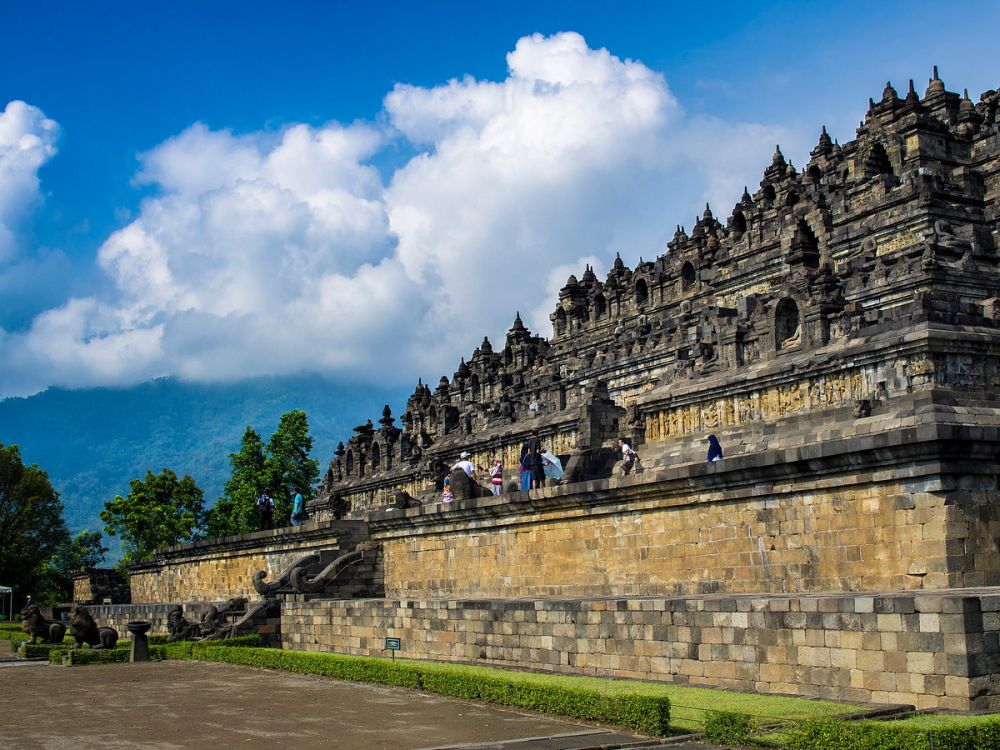Imagine standing atop an ancient marvel, the first rays of dawn painting the sky with hues of orange and purple, slowly illuminating hundreds of Buddha statues emerging from the mist. This isn’t a dream; this is the breathtaking reality of Borobudur Temple, Indonesia’s most iconic spiritual pilgrimage site and a UNESCO World Heritage wonder. If you’re planning an unforgettable journey to this majestic destination, you’ll likely be based in the vibrant city of Yogyakarta. From there, the Borobudur temple travel time from city is typically a comfortable 1 to 1.5 hours by car or tour bus, a short and scenic drive that transports you from bustling urban life to profound spiritual tranquility.
Introduction: Where Stone Speaks Volumes
Borobudur isn’t just a temple; it’s a colossal narrative carved in stone, a silent sermon whispering tales of enlightenment and ancient Javanese artistry. Built in the 9th century, this Mahayana Buddhist temple is a masterpiece of design, rising in a series of nine stacked platforms, six square and three circular, topped by a central dome. It’s an architectural marvel that continues to mystify and inspire, drawing pilgrims and travelers alike to its serene embrace. Prepare to be captivated by its sheer scale and the intricate details that adorn every single stone.
Highlights: A Symphony of Stone and Spirit
As you ascend Borobudur, the atmosphere shifts from awe to a deep sense of reverence. The air often carries a gentle humidity, occasionally mixed with the scent of tropical flora. The surrounding natural scenery is equally captivating – lush green plains stretch out to the horizon, dotted with palm trees, with the majestic peaks of Mount Merapi and Menoreh Hills providing a dramatic backdrop.

The true magic, however, lies in the temple’s structure itself. Over 2,672 bas-relief panels tell stories from Buddhist scriptures, guiding you on a spiritual journey as you circumambulate each level. You’ll encounter 504 Buddha statues, each in a unique meditative pose, with many nestled within perforated stupas on the upper circular terraces. The feeling of discovery, of piecing together this ancient puzzle, is incredibly rewarding. It’s a place where history, art, and spirituality converge, offering a profound sense of peace and wonder. What stories do these silent Buddhas hold? You’ll find yourself pondering this with every step.
Activities: Embrace the Dawn, Explore the Depths
The quintessential Borobudur experience is undoubtedly the sunrise tour. Imagine arriving in the pre-dawn darkness, climbing the ancient steps, and finding your spot as the sky slowly brightens, revealing the temple’s silhouette against a canvas of fiery colors. It’s a truly magical moment, often accompanied by a misty haze that adds to its ethereal beauty. Beyond sunrise, simply exploring the temple at your own pace, tracing the stories on the reliefs, and finding your favorite Buddha statue, is an activity in itself. Don’t rush; allow the temple to speak to you.
Beyond the main temple, consider a gentle bicycle ride through the nearby villages. You’ll witness local life, observe traditional crafts, and perhaps even sample some home-cooked Javanese delights. Nearby, the smaller but equally significant Mendut and Pawon temples, part of the Borobudur complex, offer further insights into the region’s rich Buddhist heritage.
Travel Tips: Your Practical Guide to Borobudur
- Best Time to Visit: The dry season (May to September) offers clearer skies, ideal for sunrise views. For the iconic sunrise experience, aim to arrive between 4:00 AM and 4:30 AM. Visiting during the day is also spectacular, but the early morning offers cooler temperatures and fewer crowds.
- How to Get There: As mentioned, from Yogyakarta, the drive to Borobudur is around 1 to 1.5 hours. Options include hiring a private car with a driver, joining a guided tour (often including sunrise), or using ride-sharing apps. For the adventurous, public buses go to Jombor Terminal in Yogyakarta, from where you can catch a local bus to Borobudur.
- Entrance Fees: Borobudur has separate entrance fees for local and international visitors. As of late 2023, international adult tickets were approximately IDR 500,000 (around US$35), with discounts for children. Often, combo tickets including nearby Prambanan Temple are available, offering good value.
- What to Bring: Comfortable walking shoes are a must, as there’s a fair bit of climbing. A hat, sunglasses, and sunscreen are essential for protection from the tropical sun. Don’t forget your camera for those incredible photo opportunities, and a reusable water bottle to stay hydrated.
- Respectful Attire: While there’s no strict dress code, it’s advisable to dress modestly out of respect for the sacred site. Shoulders and knees covered are generally appreciated. Sarongs are often provided at the entrance if needed.
- Local Food & Souvenirs: After your exploration, refuel with local Javanese specialties. Try Gudeg, a sweet jackfruit stew, or Sate Klathak, unique lamb satay grilled on bicycle spokes. For souvenirs, look for beautiful batik textiles, miniature stupas, intricate wooden carvings, and local coffee to bring a piece of Indonesia home with you.
Conclusion: A Journey for the Soul
Borobudur Temple is more than just a tourist attraction; it’s a journey into history, art, and the human spirit. It’s a place that humbles you with its grandeur and inspires you with its enduring message of peace. Whether you’re a history buff, a spiritual seeker, or simply a traveler looking for an extraordinary experience, Borobudur promises to leave an indelible mark on your soul. So, pack your bags, set your alarm for an early start, and prepare to be enchanted by one of the world’s most magnificent wonders. Your adventure to the heart of Java awaits!


